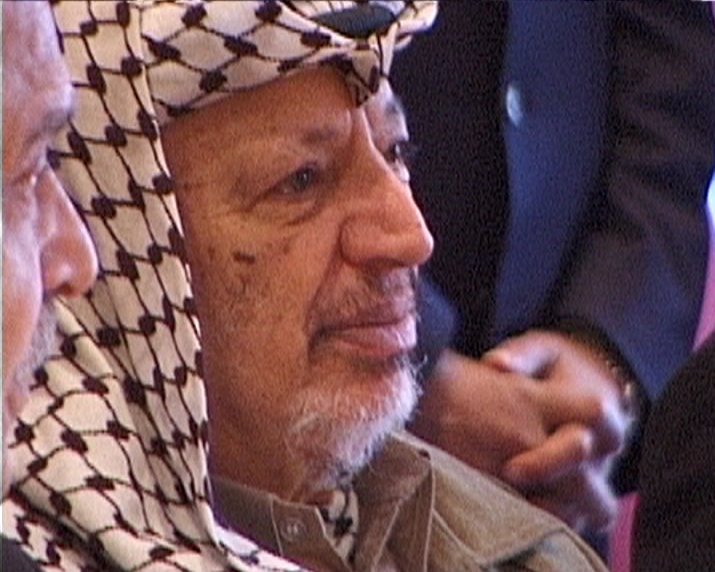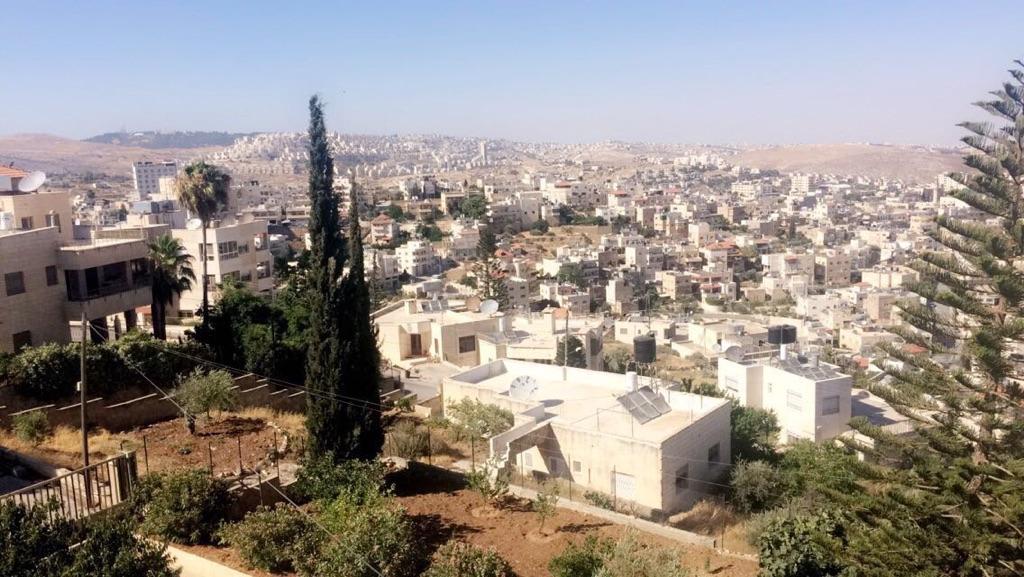|
2017 Fatah–Hamas Agreement
The 2017 Fatah–Hamas Agreement is a reconciliation agreement signed between Fatah and Hamas on 12 October 2017. The agreement was brokered by Egypt, and signed in Cairo. The deal was signed by the leader of the Fatah delegation Azzam al-Ahmad and Hamas deputy politburo chief Salah al-Arouri. As at January 2018, the parties have failed to implement the deal, arguing over the interpretation of its details and missing deadlines it set. The most contested issue between Hamas and Fatah is the future of the weapons of terrorist groups in Gaza. Hamas has said it will not accept any group conceding its weapons. Meanwhile, PA President and Fatah Chairman Mahmoud Abbas has said he would only agree to a scenario in which the PA security forces control all of Gaza's weapons. In early March 2018, an Egyptian security delegation was to arrive in Gaza to follow up on the stalled reconciliation efforts. Hamas was due to hand over control of Gaza by 1 December 2017. Both Hamas and Fatah requested ... [...More Info...] [...Related Items...] OR: [Wikipedia] [Google] [Baidu] |
Fatah
Fatah ( ar, فتح '), formerly the Palestinian National Liberation Movement, is a Palestinian nationalist social democratic political party and the largest faction of the confederated multi-party Palestine Liberation Organization (PLO) and second-largest party in the Palestinian Legislative Council (PLC). Mahmoud Abbas, the President of the Palestinian Authority, is a member of Fatah. Fatah is generally considered to have had a strong involvement in revolutionary struggle in the past and has maintained a number of militant groups.Terrorism in Tel Aviv '''' Friday, 13 Sep 1968 [...More Info...] [...Related Items...] OR: [Wikipedia] [Google] [Baidu] |
Palestinian Presidential Guard
The Palestinian Presidential Guard (PPG) ( ar, الحرس الرئاسي الفلسطيني) is a branch of the Palestinian Security Services under the direct control of the President of the State of Palestine. Its primary role is protection of the President and other VIPs, as well as execute ceremonial functions. The force may also execute special combat functions. Establishment The predecessor of the Presidential Guard was the "Presidential Security", established in 1994 by then President of the Palestinian Authority (PA), Yasser Arafat and largely composed of members from Force 17.''The Palestinian Security Services: Past and Present'' MIFTAH, 30 May 2006. "Presidential Security: What was Yasser Arafat’s former personal-security force a highly trained group of some ... [...More Info...] [...Related Items...] OR: [Wikipedia] [Google] [Baidu] |
Fatah–Hamas Conflict
The Fatah–Hamas conflict ( ar, النزاع بين فتح وحماس ''an-Nizāʿ bayna Fataḥ wa-Ḥamās'') is an ongoing political and strategic conflict between Fatah and Hamas, the two main Palestinian political parties in the Palestinian territories, leading to the Hamas takeover of the Gaza Strip in June 2007. The reconciliation process and unification of Hamas and Fatah administrations remains unfinalized and the situation is deemed a frozen conflict. The Palestinian Independent Commission for Citizens' Rights has found that over 600 Palestinians were killed in the fighting from January 2006 to May 2007. Dozens more were killed or executed in the following years as part of the conflict. Overview Hamas was founded in 1987, soon after the First Intifada broke out, as an offshoot of the Egyptian Muslim Brotherhood. It is a Palestinian Sunni-Islamist fundamentalist organization, which is regarded, either in whole or in part, as a terrorist organization by several cou ... [...More Info...] [...Related Items...] OR: [Wikipedia] [Google] [Baidu] |
Palestinian National Unity Government Of March 2007
The Second Haniyeh Government, also known as the Palestinian National Unity Government of March 2007 ( ar, المجلس الفلسطيني لآذار 17 2007), was a Palestinian Authority unity government headed by Ismail Haniyeh, the Prime Minister of the Palestinian National Authority that was formed on 17 March 2007 and dissolved on 14 June 2007. The Unity Government was formed on 17 March 2007 following negotiations in Mecca, but due to failing international support (because it did not meet the Quartet conditions), it was short-lived. Israel immediately rejected the Government and said it will deal with Abbas, but not with the new government unless it recognizes the Jewish state. Israeli officials said they would try to persuade the world not to deal with the government. The Government was dissolved by President Mahmoud Abbas on 14 June 2007 after the Hamas takeover of Gaza. Background Hamas decisively won the 2006 Palestinian legislative election held on 25 January 200 ... [...More Info...] [...Related Items...] OR: [Wikipedia] [Google] [Baidu] |
Fatah–Hamas Mecca Agreement
The Fatah–Hamas Mecca Agreement was signed between Fatah and Hamas in the city of Mecca on 8 February 2007, agreeing to stop the internal military confrontations in the Gaza Strip and form a government of national unity. Representatives from the Fatah side included the President of the Palestinian Authority Mahmoud Abbas and parliament member Mohammed Dahlan. The Palestinian Prime Minister Ismail Haniya and Khaled Mashal represented Hamas. Content The Mecca Agreement contains four determinations: # Stop and prevent the shedding of Palestinian blood; unite and confront the occupation; adopt the language of dialogue as the sole basis for solving the political disagreements # Form a Palestinian national unity government #Activate and reform the PLO and accelerate the work of the preparatory committee based on the Cairo and Damascus Understandings #Political partnership on the basis of the effective laws in the PNA and on the basis of political pluralism Mecca agreement text ... [...More Info...] [...Related Items...] OR: [Wikipedia] [Google] [Baidu] |
Fatah–Hamas Doha Agreement
The Fatah–Hamas Doha Agreement was a reconciliation attempt between Fatah and Hamas, signed on 7 February 2012. The parties agreed to form an interim national consensus government composed of independent technocrats, to prepare for upcoming elections. It would be led by Palestinian Authority President Mahmoud Abbas. The envisioned government did not materialize. The Agreement The Fatah–Hamas Doha agreement was signed on 7 February 2012 by President Mahmoud Abbas and Hamas chief Khaled Meshal in the presence of Qatar's emir Sheikh Hamad bin Khalifa Al Thani, intended to end the Fatah–Hamas conflict. President Mahmoud Abbas would head a unity caretaker cabinet. The Cabinet would be composed of independent technocrats. The task of the new government would be the preparation for upcoming elections and also overseeing reconstruction efforts in the Gaza Strip. Abbas initially wanted Salam Fayyad as PM, but this was rejected by Hamas. [...More Info...] [...Related Items...] OR: [Wikipedia] [Google] [Baidu] |
2012 Fatah–Hamas Cairo Agreement
The 2012 Fatah–Hamas Cairo Agreement was a reconciliation accord between the ruling Palestinian National Authority Fatah, and the fundamentalist organization Hamas, which currently rules over the Gaza Strip. Signed in May 2012 by Fatah's President Mahmoud Abbas, and Hamas' leader Khaled Mashal, the objective of the agreement was the formation of an interim government in preparation for the elections for a new Palestinian government. However, the agreement soon fell apart, and steps of major reconciliation were not made until January 2013. Background Tensions between political parties Fatah and Hamas have gone on since 2007. Problems between the two parties have been numerous, but namely arguments have risen on how to deal with Israel. Hamas has written off any type of settlement with Israel, believing that it should not have a right to exist in the first place, while Fatah has agreed in the past to work with Israel. On February 8, 2007, Hamas and Fatah signed the Fatah–Hamas M ... [...More Info...] [...Related Items...] OR: [Wikipedia] [Google] [Baidu] |
2014 Fatah–Hamas Agreements
The 2014 Fatah–Hamas Agreements were two successive reconciliation agreements between Fatah and Hamas, concluded in 2014. The Gaza Agreement was signed in Gaza City on 23 April 2014 by Ismail Haniyeh, the prime minister of the Hamas administration in Gaza, and a senior Palestine Liberation Organisation delegation dispatched by Palestinian President Mahmoud Abbas. Its main purpose was reconciliation between the parties and the formation of a Palestinian Unity Government within five weeks, to be followed by general elections within six months. The Unity Government was formed on 2 June 2014. On 25 September 2014, almost 4 months after the formation of the Palestinian Unity Government, the parties concluded a second agreement, the Cairo Agreement, in Cairo, between Haniyeh and President Abbas, specifying the tasks and responsibilities of the Unity Government. The Government was to assume responsibilities in the Gaza Strip, work on re-activation of the Palestinian Legislative Counci ... [...More Info...] [...Related Items...] OR: [Wikipedia] [Google] [Baidu] |
Fatah–Hamas Reconciliation Process
The Fatah–Hamas reconciliation process refers to a series of reconciliation attempts to resolve the hostility between Fatah and Hamas since the 2006–2007 Fatah–Hamas conflict and Hamas' subsequent takeover of the Gaza Strip. Despite a number of agreements, those attempts have not yet been successful, with Hamas still exercising full control of the Gaza Strip, despite the formation of the "unity government" in June 2014. Israel and the United States have effectively opposed reconciliation, according to Jimmy Carter. Background Until the First Intifada, Fatah was the sole dominating party in the Palestinian political arena, including the PLO. In 1987, Hamas arose as a resistance movement against the Israeli occupation. Following the Oslo Accords, the PLO, of which Fatah still was the dominant member, formally denounced armed resistance. Hamas refused to recognize Israel and opposed the Oslo Accords and subsequent agreements between the PLO and Israel. Under pressure of I ... [...More Info...] [...Related Items...] OR: [Wikipedia] [Google] [Baidu] |
Mahmoud Abbas
Mahmoud Abbas ( ar, مَحْمُود عَبَّاس, Maḥmūd ʿAbbās; born 15 November 1935), also known by the kunya Abu Mazen ( ar, أَبُو مَازِن, links=no, ), is the president of the State of Palestine and the Palestinian National Authority. He has been the chairman of the Palestine Liberation Organization ( PLO) since 11 November 2004, PNA president since 15 January 2005, and State of Palestine president since 8 May 2005. Abbas is also a member of the Fatah party and was elected chairman in 2009. Abbas was elected on 9 January 2005 to serve as President of the Palestinian National Authority until 15 January 2009, but extended his term until the next election in 2010, citing the PLO constitution, and on 16 December 2009 was voted into office indefinitely by the PLO Central Council. As a result, Fatah's main rival, Hamas, initially announced that it would not recognize the extension or view Abbas as the rightful president. Nonetheless, Abbas is internationally re ... [...More Info...] [...Related Items...] OR: [Wikipedia] [Google] [Baidu] |
Rafah Border Crossing
The Rafah Border Crossing ( ar, معبر رفح, Ma`bar Rafaḥ) or Rafah Crossing Point is the sole crossing point between Egypt and the Gaza Strip. It is located on the Gaza–Egypt border, which was recognized by the 1979 Egypt–Israel peace treaty. The original crossing point was named Rafah land port. Only passage of persons takes place through the Rafah Border Crossing. Traffic of goods is mostly diverted to the Kerem Shalom border crossing. The gates The ''Rafah Land Port'' became the primary border crossing between Egypt and Gaza, managed by the Israel Airports Authority until Israel had dismantled its settlements in Gaza on 11 September 2005 as part of a disengagement plan. It subsequently became the task of the European Union Border Assistance Mission Rafah (EUBAM) to monitor the crossing. The ''Rafah land port'', known as the "Salah al Din Gate" is located at the original Rafah crossing on the Salah al-Din Road, the main highway of Gaza from Erez to Rafah. Rafah ... [...More Info...] [...Related Items...] OR: [Wikipedia] [Google] [Baidu] |



